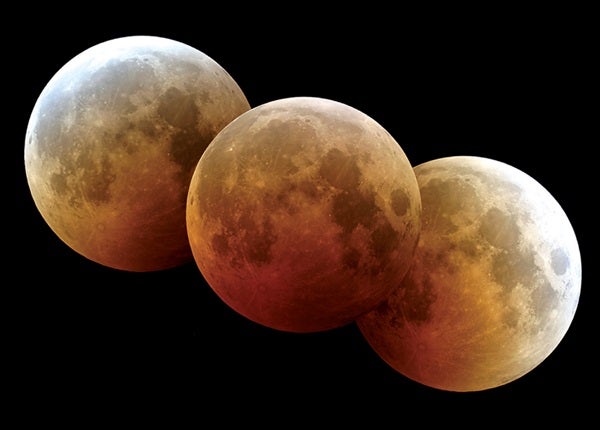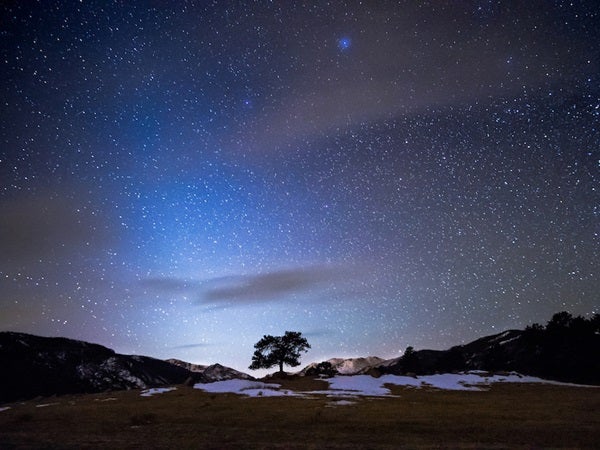The waxing gibbous Moon slides eastward through Taurus tonight. Once darkness falls across North America, you can see the lovely Hyades star cluster perched just east of Earth’s satellite. As the night wears on, the Moon moves into the V-shaped Hyades and approaches 1st-magnitude Aldebaran. (Although this star appears to belong to the cluster, it lies only half as far away.) From the northwestern United States and western Canada, the Moon passes directly in front of the star just before the pair sets.
Saturday, January 27
Head outside before dawn and you can’t miss Jupiter. The giant planet rises shortly before 2 a.m. local time and climbs 30° high in the south-southeast by the time twilight commences. Jupiter shines at magnitude –1.9, which makes it the brightest point of light in the night sky, and resides among the much dimmer stars of the constellation Libra. A telescope reveals the planet’s 35″-diameter disk.
Sunday, January 28
One of the sky’s most familiar constellations rules January’s sky from dusk until around 3 a.m. local time. Orion the Hunter appears conspicuous in the southeast after darkness falls and climbs highest in the south around 9 p.m. It then stands about halfway to the zenith from mid-northern latitudes. The waxing gibbous Moon stands above Orion late this evening, while the night sky’s brightest star, Sirius, trails about an hour behind the Hunter.
Monday, January 29
Although Saturn passed on the opposite side of the Sun from Earth only a month ago, it already appears low in the southeast before dawn. From mid-northern latitudes, the ringed planet lies 10° above the horizon an hour before sunrise. It shines at magnitude 0.5, which makes it the brightest point of light in this part of the sky.
Anyone with clear skies in North America and across the Pacific Ocean to Australia and eastern Asia can witness this week’s biggest event: a total eclipse of the Moon. The Full Moon, which arrives officially at 8:27 a.m. EST tomorrow morning, then lies deep in Earth’s shadow and will dim considerably while likely taking on an orange hue. From North America, the eclipse occurs before dawn and delivers better views to those who live farther west. The eclipse’s partial phases start at 6:48 a.m. EST (3:48 a.m. PST). Those in the continent’s western two-thirds can view at least some of totality, which gets underway at 6:52 a.m. CST (4:52 a.m. PST). Totality last 76 minutes and can be seen in its entirety west of a line that runs from central North Dakota to New Mexico. The eclipsed Moon hangs among the background stars of Cancer with the Beehive star cluster (M44) 4° to its northwest.
The Moon reaches perigee, the closest point in its orbit around Earth, just 27 hours before it is Full. At 4:57 a.m. EST on the 30th, it lies 223,068 miles (358,994 kilometers) away from us.
Wednesday, January 31
Mars stands out in the southeastern sky before dawn this week. The magnitude 1.2 Red Planet rises around 2:30 a.m. local time and appears 25° high as twilight starts to paint the sky. It exits the constellation Libra today and moves into Scorpius, standing 9° above the latter constellation’s brightest star, magnitude 1.1 Antares.. Unfortunately, the view of Mars through a telescope proves disappointing — its disk spans only 6″ and shows no detail.
Thursday, February 1
The dwarf planet Ceres reached opposition and peak visibility yesterday, but it remains a fine sight throughout February. It currently shines at magnitude 6.9 and is an easy object to spot through binoculars. The largest member of the asteroid belt resides in the constellation Cancer the Crab, which appears in the east once darkness falls and climbs highest in the south around midnight local time. This evening, Ceres lies 0.9° northeast of the 5th-magnitude star Tau (τ) Cancri.
Tonight should provide your first good opportunity of 2018 to view the zodiacal light. From the Northern Hemisphere, late winter and early spring are the best times of year to observe this elusive glow after sunset. It appears slightly fainter than the Milky Way, so you’ll need a clear moonless sky and an observing site located far from the city. With the waning gibbous Moon now exiting the early evening sky, the next two weeks will be prime viewing times. Look for the cone-shaped glow, which has a broad base and points nearly straight up from the western horizon, after the last vestiges of twilight have faded away.
For those who believe in folklore, the fate of winter rests on the shoulders of the groundhog. If the furry rodent sticks his head out of his burrow this morning and sees his shadow, we’ll have six more weeks of winter. But if the weather is cloudy, it means spring is right around the corner. What does this have to do with astronomy? Groundhog Day celebrates one of the four so-called cross-quarter days, which mark the midpoints between the solstices and equinoxes. February 2 falls approximately midway between the winter solstice and the vernal equinox.
Saturday, February 3
Comet PANSTARRS (C/2016 R2) currently glows between 10th and 11th magnitude, which makes it a tempting target through telescopes for those under a dark sky. What makes it even more tempting is its location in Taurus: The comet spends February’s first week just 2° east of the stunning Pleiades star cluster (M45). Look for a small, round, diffuse glow similar to a companion galaxy in the Virgo Cluster.
Sunday, February 4
The variable star Algol in Perseus reaches minimum brightness at 8:19 p.m. EST, when it shines at magnitude 3.4. If you start viewing as soon as darkness falls, you can watch it more than triple in brightness (to magnitude 2.1) over the course of about five hours. This eclipsing binary star runs through a cycle from minimum to maximum and back every 2.87 days. Algol appears nearly overhead after sunset and sinks low in the northwest well after midnight.












